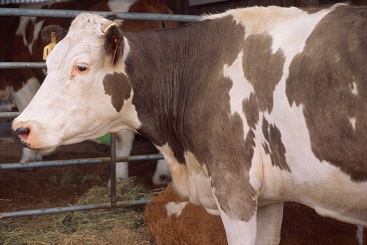
All breeds of cattle technically have the potential to be dual purpose breeds, as all cattle breed can produce meat and milk. The term dual purpose is however used to describe breeds which can produce both meat and milk to satisfactory levels. Dual purpose breeds would never claim to have milk production levels as high as a straight dairy breed or quality meat production as a straight beef breed, however they may prove to be profitable in combination of these two products.
One of the most popular duel purpose breeds is the Simmental.
Simmental cattle are also known as Fleckvieh Simmental in Argentinia, sometimes referred to as Pie Rouge in France and Fleckvieh in Germany.
Simmentals can be thought of as a group of several related breeds, originating in Switzerland. An old breed recorded in the middle ages, which has been used in development of several other European breeds (including Montbeliarde, Razzetta d’Orpa).
Arguably Simmentals are the main dual purpose breed farmed in Europe, having been used to produce both meat and milk. Originally also used as a draught animal in Europe. Renowned for rapid growth in calves if fed well, results in exceptional weight gain and milk yield. Outside Europe, raised mainly for meat.
The second most widely farmed breeds of cattle worldwide, second to the Zebu cattle. Adapts to varied conditions, from large scale properties to small hobby farms. They are farmed widely in most parts of Europe, the U.K, the Soviet Union, South Africa, Canada, the U.S.A, Australia, and Argentina. Being such a widely used cattle, the type and appearance of the Simmental can vary with country or region, according to environment or production demands (see below for descriptions of some of these).
Characteristics: Colour is more varied than almost any other type of cattle. The traditional colour is either red with white patches or gold-cream with white; but those colours are now much more varied. A white face is common, but others can be black all over with no markings. Most have pigment around they eyes which can help reduce health issues caused by UV rays. Most are naturally horned, but they can come in polled varieties.
Typically they are relatively docile and are good mothers. Mature bulls can reach 1000kg to 1200kg.Cows can will reach 550kg to 800kg.
Types or variations of Simmental cattle
Black Simmental –developed by cross breeding with black or grey coat cattle breeds (eg. Angus, Murray Grey); but maintaining at least 15/16 Simmental genome. They have all the attributes of other Simmentals, but also advantage of a black coat and most are polled. They may have some further advantages in a quieter temperament, boosted weight gain and milk yield and higher fertility.
Fleckvieh – Is the German name for Simmental developed in Austria or Germany for dual purpose farming (milk and meat); Red or pale brownish coat commonly with white patches, also a white face.
Pie Rouge –Simmental cattle may be still referred to as ‘Pie Rouge’ is areas of France.
Red Simmental –has more red colour on head body and legs than other Simmentals, some are solid red with no white markings, and always red pigment in the eye. Bred from other variations of Simmental, maintains at least 15/16 Simmental genome.
An extract from our ebook Cattle Breeds to be published in March 2014.